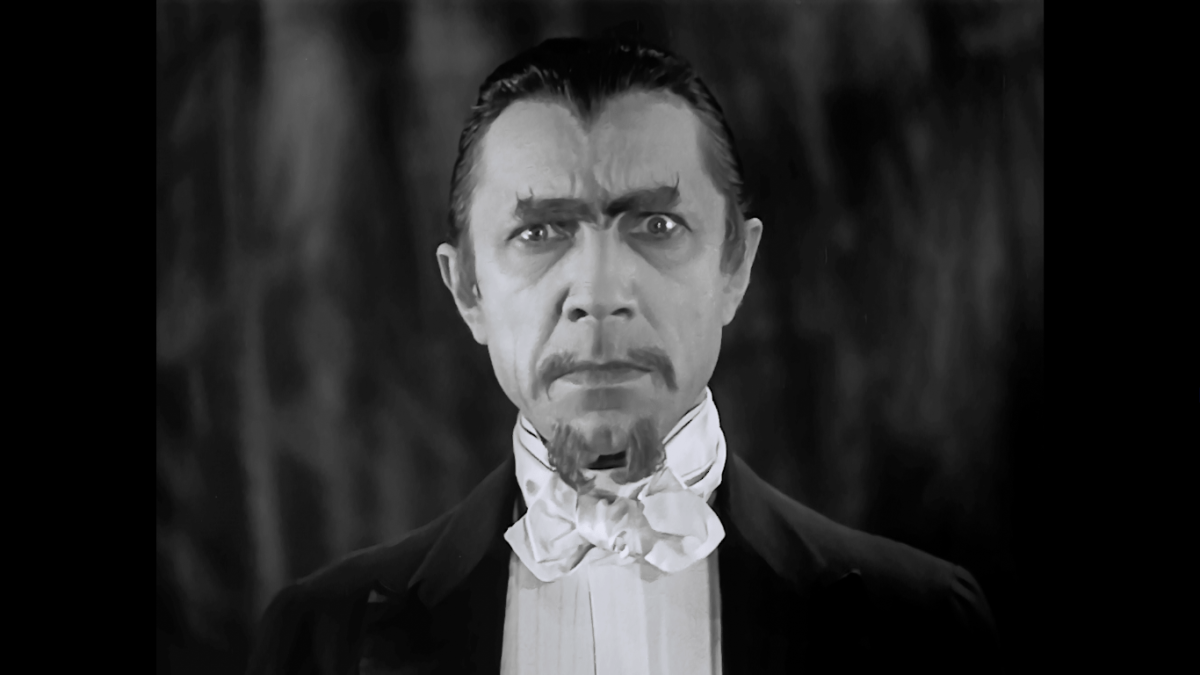
White Zombie (Victor Halperin, 1932, 69 min.)
Made on a shoestring budget with bad actors and painted backdrops, this early horror classic still holds up as an entrancing and spooky masterpiece of sorts. It’s hard to pin down why it works; it’s easier to list its faults than to state clearly why it is so hypnotic. It has something to do with the presence of Bela Lugosi, still threatening and noble looking a couple of years after Dracula, the high point and beginning of the end for his film career. Perhaps it’s the sets that look like castoffs from a real studio’s prop room, which add to the theatrical and expressionistic feel of the film. Whatever it is, this is a memorable film, an unjustly unheralded horror film that, unlike many of the best-remembered shockers of its era, still manages to frighten.
A beautiful young woman, Madeline (Madge Bellamy), and her fiancé Neil (John Harron) have come to Haiti to stay with a man they met on a cruise. While riding in a coach on a moonless night, they encounter a strange scene, a burial at a crossroads, where the locals punish grave robbers by burying their bodies where they will have no peace. They also encounter a strange and threatening man (Bela Lugosi), who seems to hypnotize Madeline with his gaze; he steals her scarf when Neil forces the coachman to drive away. Their host, Beaumont (Robert Frazer) seems to be a nice guy: he’s offered his house for their wedding, and he’s even enlisted the local doctor/priest, Bruner (Joseph Cawthorn), to do the honors. Beaumont has a secret, though: he’s in love with Madeline, and when she won’t marry him instead of Neil, he enlists the help of “Murder” Legendre, the guy from the crossroads, who runs a sugarcane plantation and mill. He uses a mysterious powder to zombify his enemies and some of the locals. In the film’s most frightening and expressionistic scene, Beaumont is led through the mill, where empty-faced zombies struggle to turn a huge wooden wheel, its groans filling the room (the sound on this film, although scratchy with age, is memorable, a near-genius use of sound in an era when the novelty of having sound seemed to be enough for most filmmakers).
Hoping to capitalize on Bela Lugosi’s popularity after 1930’s Dracula, Victor Halperin cast him in a similar part here. His “Murder” Legendre uses many of the same techniques as Dracula did: his hypnotic eyes, commanding gestures that seem to rule out any disobedience, and a regal bearing that seems to summon all the noble decadence of Europe. He strikes a bargain with Beaumont, giving him some of the zombie powder (“Just a pinpoint is all that’s needed,” he repeats) in exchange for some unstated return. Beaumont uses a rose to poison Madeline and, as Legendre performs some rite outside, she falls ill and seems to die. The crosscutting between Madeline’s spoiled wedding reception and Legendre’s magicking outside is a thrill to watch. Madeline keels over and is buried. In another great scene, while Neil drowns his sorrows in alcohol and grasps at shadows that bear Madeline’s face, Legendre’s zombies carry her from her mausoleum into his castle, where Beaumont discovers that having a zombie as a girlfriend isn’t what he expected. She’s not the vivacious and beautiful thing he fell in love with, and he begs Legendre to put her back the way she was. However, Legendre’s bargain quickly reveals itself to be a bum deal.
The film is filled with surprisingly striking images. The aforementioned sugar mill tops the list, but there are many others: a repeated shot of Madeline walking down a majestic staircase in Legendre’s castle, which is shot through a fleur d’elise carved out of the bannister that is reflected in her gown; a shot of her leaning out of the window of the castle, which is superimposed on a painted backdrop showing the rest of the castle as Neil calls to her from below; and an amazing fade from the coach that carries Madeline and Neil into a shot of Legendre’s menacing stare. What’s amazing is that this is probably the only good movie that Halperin ever made. He made an atrocious “sequel” called Revolt of the Zombies in 1936, sans Lugosi, then he faded into obscurity.
A short history lesson: the United States occupied Haiti beginning in 1915. In 1929, a series of major revolts against US military rule, brought about in part by the US practice of using forced labor to build roads, led to an agreement by the US to get out of Haiti before their agreed-on date of 1936. This was achieved in 1934, two years after this film was made. It was during this time that Americans got wind of voodoo, a syncretic religion that combined Catholicism with the African religions of the former slaves, and its most infamous offshoot, the purported existence of zombies. I’m sure this film seemed timely when it came out, dealing with the occupation of Haiti, and indirectly with some of the methods of the occupation. The US military forced Haitians to build roads for them, and that’s not a far cry from Legendre’s forcing people to work his mill. The film almost works as a criticism, albeit a weak one, of US policy.

